
Illustrative Math Alignment: Grade 6 Unit 1
Dividing Fractions
Lesson 17: Fitting Boxes into Boxes
Use the following Media4Math resources with this Illustrative Math lesson.
| Thumbnail Image | Title | Body | Curriculum Nodes |
|---|---|---|---|
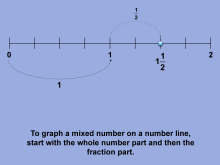
|
Math Clip Art--Fraction Concepts--Mixed Numbers 04 | Math Clip Art--Fraction Concepts--Mixed Numbers 04TopicFractions DescriptionThis image is a variation of the previous one, for 1 1/2, showing the whole number part on the number line and then the fractional part. It displays a number line with the whole number 1 clearly marked, and then shows how the additional 1/2 is added to reach the final position of 1 1/2. This representation helps students understand how mixed numbers are constructed on a number line, breaking down the process into two steps: locating the whole number, then adding the fraction. It reinforces the concept that mixed numbers combine whole numbers and fractions. |
Fractions and Mixed Numbers |
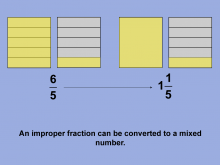
|
Math Clip Art--Fraction Concepts--Mixed Numbers 06 | Math Clip Art--Fraction Concepts--Mixed Numbers 06TopicFractions DescriptionThis image presents rectangular models for 6/5 and 1 1/5. It shows two sets of rectangles: one modeling 6/5 and the other modeling 1 1/5. This representation helps students visualize the relationship between improper fractions and mixed numbers. It demonstrates how an improper fraction like 6/5 can be expressed as a mixed number 1 1/5, showing that they represent the same quantity. Teachers can use this image to discuss the conversion between improper fractions and mixed numbers, and to reinforce the concept that mixed numbers represent quantities greater than one whole. |
Fractions and Mixed Numbers |
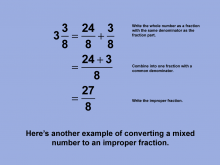
|
Math Clip Art--Fraction Concepts--Mixed Numbers 11 | Math Clip Art--Fraction Concepts--Mixed Numbers 11TopicFractions DescriptionThis image shows a variation of the previous concept, now converting 3 3/8 to 27/8. It displays the step-by-step process of multiplying 3 by 8 to get 24, adding 3, and then writing 27 over 8. This representation builds on the previous example, helping students see how the process works with larger mixed numbers. It reinforces the concept that the numerator of the resulting improper fraction will always be larger than the denominator when converting from a mixed number. |
Fractions and Mixed Numbers |
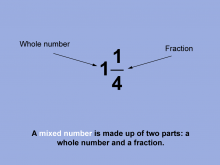
|
Math Clip Art--Fraction Concepts--Mixed Numbers 02 | Math Clip Art--Fraction Concepts--Mixed Numbers 02TopicFractions DescriptionThis image presents the mixed number 1 1/4 with the whole number part labeled and the fraction part clearly identified. It shows the number 1 1/4 with arrows or labels pointing to the '1' as the whole number part and '1/4' as the fraction part. This representation helps students understand the structure of mixed numbers, showing how they combine a whole number with a proper fraction. It provides a clear visual breakdown of the components of a mixed number. |
Fractions and Mixed Numbers |
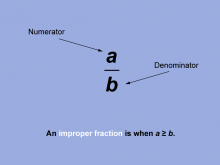
|
Math Clip Art--Fraction Concepts--Proper and Improper Fractions 08 | Math Clip Art--Fraction Concepts--Proper and Improper Fractions 08TopicFractions DescriptionThis image introduces the concept of improper fractions, stating that a fraction a/b is improper if a is greater than or equal to b. It displays the fraction a/b with a visual or textual explanation indicating that when the numerator is greater than or equal to the denominator, the fraction is improper. This representation helps students understand the definition of improper fractions and how they differ from proper fractions. It sets the stage for exploring fractions that represent one whole or more than one whole. |
Identify and Name Fractions |
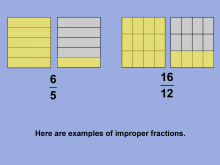
|
Math Clip Art--Fraction Concepts--Proper and Improper Fractions 09 | Math Clip Art--Fraction Concepts--Proper and Improper Fractions 09TopicFractions DescriptionThis image provides visual models of improper fractions using rectangular models for 6/5 and 16/12. It shows two rectangles: one divided into 5 parts with 6 parts shaded (extending beyond the original rectangle), and another divided into 12 parts with 16 parts shaded. This representation helps students visualize improper fractions and understand that they represent more than one whole. It demonstrates how improper fractions can be represented visually, even when they exceed one complete unit. |
Identify and Name Fractions |
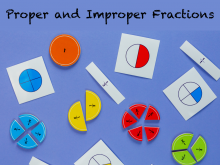
|
Math Clip Art--Fraction Concepts--Proper and Improper Fractions 01 | Math Clip Art--Fraction Concepts--Proper and Improper Fractions 01TopicFractions DescriptionThis image serves as the title card for a series on proper and improper fractions. It displays the text "Proper and Improper Fractions" in a clear, prominent font. The background may include subtle mathematical elements or fraction-related graphics to set the context for the following images in the series. This introductory image sets the stage for the subsequent images, preparing students for an exploration of the differences between proper and improper fractions. It provides a clear, concise title that immediately informs viewers about the specific fraction concepts they'll be studying. |
Identify and Name Fractions |

|
Math Clip Art--Fraction Concepts--Proper and Improper Fractions 02 | Math Clip Art--Fraction Concepts--Proper and Improper Fractions 02TopicFractions DescriptionThis image shows 1/4 with labels for numerator and denominator. It displays the fraction 1/4 with the number 1 clearly labeled as the numerator and the number 4 labeled as the denominator. This representation helps students understand the basic structure of a fraction, identifying the roles of the numerator and denominator. It reinforces the concept that the numerator represents the number of parts being considered, while the denominator represents the total number of equal parts the whole is divided into. |
Identify and Name Fractions |
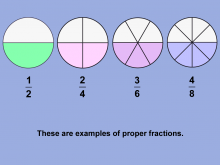
|
Math Clip Art--Fraction Concepts--Proper and Improper Fractions 05 | Math Clip Art--Fraction Concepts--Proper and Improper Fractions 05TopicFractions DescriptionThis image provides examples of proper fractions shown as circular fractions: 1/2, 2/4, 3/6, and 4/8. It displays four circles, each divided into the appropriate number of sections with the corresponding number of sections shaded to represent each fraction. This visual representation helps students see that these fractions, while written differently, all represent proper fractions (less than one whole). It reinforces the concept of proper fractions and introduces the idea of equivalent fractions. |
Identify and Name Fractions |
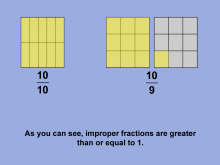
|
Math Clip Art--Fraction Concepts--Proper and Improper Fractions 10 | Math Clip Art--Fraction Concepts--Proper and Improper Fractions 10TopicFractions DescriptionThis image is a variation of the previous one, now showing visual models for 10/10 and 10/9. It displays rectangular visual representations: one divided into 10 parts with all 10 parts shaded, and another pair of rectangles divided into 9 parts with 10 parts shaded. This representation helps students understand that improper fractions include fractions equal to one whole (like 10/10) as well as those greater than one whole (like 10/9). It reinforces the concept that improper fractions have numerators greater than or equal to their denominators. |
Identify and Name Fractions |

|
Math Clip Art--Fraction Concepts--Proper and Improper Fractions 04 | Math Clip Art--Fraction Concepts--Proper and Improper Fractions 04TopicFractions DescriptionThis image is a variation of the previous one, now showing that for a proper fraction, a < b. It displays the fraction a/b again, but with an additional note or visual indicator that the numerator (a) is less than the denominator (b). This representation introduces the concept of proper fractions, helping students understand that when the numerator is less than the denominator, the fraction represents a part of a whole that is less than one. |
Identify and Name Fractions |
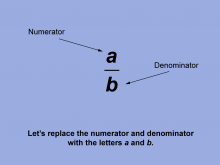
|
Math Clip Art--Fraction Concepts--Proper and Improper Fractions 03 | Math Clip Art--Fraction Concepts--Proper and Improper Fractions 03TopicFractions DescriptionThis image shows a/b for any whole number a and b, with b not equal to zero. It displays the fraction a/b with labels or explanations indicating that a and b can be any whole numbers, but b cannot be zero. This representation introduces students to the general form of a fraction and the important rule that the denominator cannot be zero. It helps students understand that fractions can represent a wide range of values and prepares them for working with variables in algebraic fractions. |
Identify and Name Fractions |

|
Math Clip Art--Fraction Concepts--Proper and Improper Fractions 07 | Math Clip Art--Fraction Concepts--Proper and Improper Fractions 07TopicFractions DescriptionThis image shows another variation with these fractions: 1/4, 3/8, 5/12, and 15/16, emphasizing that proper fractions are less than 1. It displays visual models for each fraction, clearly showing that the shaded portion is less than the whole in each case. This representation further reinforces the concept of proper fractions, showing examples with increasingly larger denominators. It helps students understand that even as fractions get closer to 1, they remain proper fractions as long as the numerator is less than the denominator. |
Identify and Name Fractions |
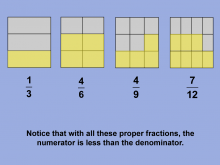
|
Math Clip Art--Fraction Concepts--Proper and Improper Fractions 06 | Math Clip Art--Fraction Concepts--Proper and Improper Fractions 06TopicFractions DescriptionThis image presents a variation of the previous concept, now using rectangular models to show proper fractions: 1/3, 4/6, 4/9, and 7/12. It displays four rectangles, each divided into the appropriate number of sections with the corresponding number of sections shaded to represent each fraction. |
Identify and Name Fractions |
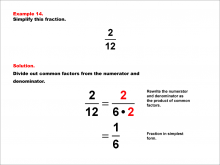
|
Math Example--Fraction Properties--Simplifying Fractions--Example 14 | Simplifying Fractions--Example 14TopicFractions DescriptionThis example demonstrates simplifying the fraction 2/12 by finding the GCD, which is 2. The simplified form is 1/6. This teaches students about recognizing common factors and reducing fractions to their simplest form. For a complete collection of math examples related to Simplifying Fractions click on this link: Math Examples: Simplifying Fractions Collection. |
Write Fractions in Lowest Terms |

|
Math Example--Fraction Properties--Simplifying Fractions--Example 5 | Simplifying Fractions--Example 5TopicFractions DescriptionFocusing on the fraction 2/8, this example highlights the process of finding the GCD, which is 2. Through division, students simplify the fraction to 1/4. This exercise reinforces their skills in problem-solving and critical thinking regarding fractions. For a complete collection of math examples related to Simplifying Fractions click on this link: Math Examples: Simplifying Fractions Collection. |
Write Fractions in Lowest Terms |
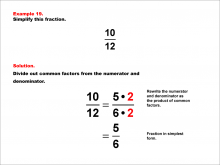
|
Math Example--Fraction Properties--Simplifying Fractions--Example 19 | Simplifying Fractions--Example 19TopicFractions DescriptionThis example demonstrates simplifying the fraction 10/12 by finding the GCD, which is 2. The simplified form is 5/6. This teaches students about recognizing common factors and reducing fractions to their simplest form. For a complete collection of math examples related to Simplifying Fractions click on this link: Math Examples: Simplifying Fractions Collection. |
Write Fractions in Lowest Terms |
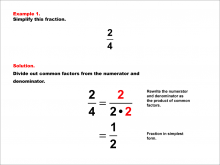
|
Math Example--Fraction Properties--Simplifying Fractions--Example 1 | Simplifying Fractions--Example 1TopicFractions DescriptionThis example demonstrates the concept of simplifying fractions, in which students are guided through the process of reducing a fraction to its simplest form. It emphasizes identifying the greatest common divisor (GCD) and dividing both the numerator and denominator by this value. Solving problems like this enhances skills in recognizing factors, understanding number properties, and executing division. This example is a crucial building block for understanding more complex fraction operations, establishing a solid foundation for students. |
Write Fractions in Lowest Terms |

|
Math Example--Fraction Properties--Simplifying Fractions--Example 18 | Math Example--Fraction Properties--Simplifying Fractions--Example 18TopicFractions DescriptionThis example demonstrates simplifying the fraction 8/12 by finding the GCD, which is 4. The simplified form is 2/3. This teaches students about recognizing common factors and reducing fractions to their simplest form. For a complete collection of math examples related to Simplifying Fractions click on this link: Math Examples: Simplifying Fractions Collection. |
Write Fractions in Lowest Terms |

|
Math Example--Fraction Properties--Simplifying Fractions--Example 13 | Simplifying Fractions--Example 13TopicFractions DescriptionThis example demonstrates simplifying the fraction 8/10 by finding the GCD, which is 2. The simplified form is 4/5. This teaches students about recognizing common factors and reducing fractions to their simplest form. For a complete collection of math examples related to Simplifying Fractions click on this link: Math Examples: Simplifying Fractions Collection. |
Write Fractions in Lowest Terms |
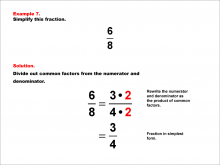
|
Math Example--Fraction Properties--Simplifying Fractions--Example 7 | Simplifying Fractions--Example 7TopicFractions DescriptionIn this case, the fraction 6/8 is shown, where the GCD is identified as 2. Simplifying the fraction leads to 3/4, a practical example that helps students master the concept of equivalent fractions and the importance of factoring in mathematics. For a complete collection of math examples related to Simplifying Fractions click on this link: Math Examples: Simplifying Fractions Collection. |
Write Fractions in Lowest Terms |
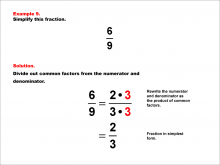
|
Math Example--Fraction Properties--Simplifying Fractions--Example 9 | Simplifying Fractions--Example 9TopicFractions DescriptionThis example demonstrates the simplification of the fraction 6/9. Students identify the GCD as 3, simplifying the fraction to 2/3. This exercise enhances their understanding of division and equivalent fractions, essential for advanced mathematical concepts. For a complete collection of math examples related to Simplifying Fractions click on this link: Math Examples: Simplifying Fractions Collection. |
Write Fractions in Lowest Terms |
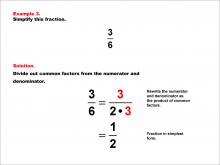
|
Math Example--Fraction Properties--Simplifying Fractions--Example 3 | Simplifying Fractions--Example 3TopicFractions DescriptionIn this example, the concept of simplifying the fraction 3/6 is demonstrated. The goal is to show students how to find the greatest common divisor (GCD) of the numerator and denominator. By dividing both by 3, the fraction simplifies to its simplest form, 1/2. This activity promotes skills in fraction manipulation and the understanding of equivalent fractions. For a complete collection of math examples related to Simplifying Fractions click on this link: Math Examples: Simplifying Fractions Collection. |
Write Fractions in Lowest Terms |
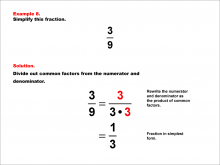
|
Math Example--Fraction Properties--Simplifying Fractions--Example 8 | Simplifying Fractions--Example 8TopicFractions DescriptionHere, the fraction 3/9 is presented. Students are encouraged to find the GCD, noted as 3, allowing them to reduce to 1/3, showcasing critical skills in fraction simplification and equivalent identification. For a complete collection of math examples related to Simplifying Fractions click on this link: Math Examples: Simplifying Fractions Collection. |
Write Fractions in Lowest Terms |
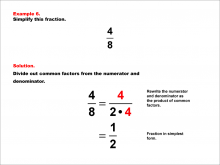
|
Math Example--Fraction Properties--Simplifying Fractions--Example 6 | Simplifying Fractions--Example 6TopicFractions DescriptionThis example presents the fraction 4/8 and guides students to recognize that the GCD is 4. Simplifying to 1/2, this problem emphasizes the significance of understanding common factors in fractions, an essential skill in mathematics. For a complete collection of math examples related to Simplifying Fractions click on this link: Math Examples: Simplifying Fractions Collection. |
Write Fractions in Lowest Terms |
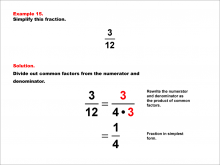
|
Math Example--Fraction Properties--Simplifying Fractions--Example 15 | Simplifying Fractions--Example 15TopicFractions DescriptionThis example demonstrates simplifying the fraction 3/12 by finding the GCD, which is 3. The simplified form is 1/4. This teaches students about recognizing common factors and reducing fractions to their simplest form. For a complete collection of math examples related to Simplifying Fractions click on this link: Math Examples: Simplifying Fractions Collection. |
Write Fractions in Lowest Terms |

|
Math Example--Fraction Properties--Simplifying Fractions--Example 16 | Simplifying Fractions--Example 16TopicFractions DescriptionThis example demonstrates simplifying the fraction 4/12 by finding the GCD, which is 4. The simplified form is 1/3. This teaches students about recognizing common factors and reducing fractions to their simplest form. For a complete collection of math examples related to Simplifying Fractions click on this link: Math Examples: Simplifying Fractions Collection. |
Write Fractions in Lowest Terms |

|
Math Example--Fraction Properties--Simplifying Fractions--Example 2 | Simplifying Fractions--Example 2TopicFractions DescriptionThis example focuses on strategies for simplifying the fraction 2/6. Students learn to find the GCD of 2 and 6, which is 2, to reduce the fraction to its simplified form, 1/3. The activity not only sharpens their division skills but also develops their understanding of equivalent fractions, allowing them to visualize how different fractions can represent the same value while fostering critical thinking about numerators and denominators. |
Write Fractions in Lowest Terms |
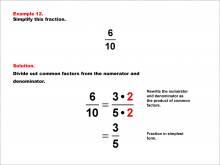
|
Math Example--Fraction Properties--Simplifying Fractions--Example 12 | Math Example--Fraction Properties--Simplifying Fractions--Example 12TopicFractions DescriptionThis example demonstrates simplifying the fraction 6/10 by finding the GCD, which is 2. The simplified form is 3/5. This teaches students about recognizing common factors and reducing fractions to their simplest form. For a complete collection of math examples related to Simplifying Fractions click on this link: Math Examples: Simplifying Fractions Collection. |
Write Fractions in Lowest Terms |
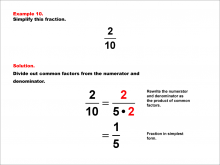
|
Math Example--Fraction Properties--Simplifying Fractions--Example 10 | Simplifying Fractions--Example 10TopicFractions DescriptionThis example focuses on simplifying the fraction 2/10. By finding the GCD, which is 2, students simplify the fraction to 1/5. This activity reinforces their skills in recognizing common factors and understanding equivalent fractions. For a complete collection of math examples related to Simplifying Fractions click on this link: Math Examples: Simplifying Fractions Collection. |
Write Fractions in Lowest Terms |

|
Math Example--Fraction Properties--Simplifying Fractions--Example 17 | Math Example--Fraction Properties--Simplifying Fractions--Example 17TopicFractions DescriptionThis example demonstrates simplifying the fraction 6/12 by finding the GCD, which is 6. The simplified form is 1/2. This teaches students about recognizing common factors and reducing fractions to their simplest form. For a complete collection of math examples related to Simplifying Fractions click on this link: Math Examples: Simplifying Fractions Collection. |
Write Fractions in Lowest Terms |
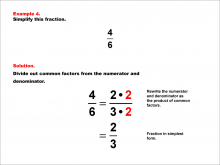
|
Math Example--Fraction Properties--Simplifying Fractions--Example 4 | Simplifying Fractions--Example 4TopicFractions DescriptionThis example illustrates the simplification of 4/6. Students learn to identify the GCD, which is 2, allowing them to reduce the fraction to 2/3. This practice strengthens their skills in division and enhances their understanding of number relationships, vital for more complex fraction concepts. For a complete collection of math examples related to Simplifying Fractions click on this link: Math Examples: Simplifying Fractions Collection. |
Write Fractions in Lowest Terms |
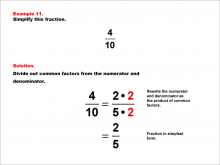
|
Math Example--Fraction Properties--Simplifying Fractions--Example 11 | Simplifying Fractions--Example 11TopicFractions DescriptionThis example demonstrates simplifying the fraction 4/10 by finding the greatest common divisor (GCD), which is 2. The simplified form is 2/5. This teaches students about recognizing common factors and reducing fractions to their simplest form. For a complete collection of math examples related to Simplifying Fractions click on this link: Math Examples: Simplifying Fractions Collection. |
Write Fractions in Lowest Terms |
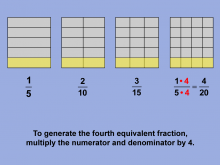
|
Math Clip Art--Fraction Concepts--Equivalent Fractions 09 | Math Clip Art--Fraction Concepts--Equivalent Fractions 09TopicFractions DescriptionThis image completes the short sequence by showing 4/20 with a rectangular model and the numerical process to generate this equivalent fraction. It displays a rectangle divided into 20 parts with four parts shaded, alongside the numerical process of multiplying both the numerator and denominator of 1/5 by 4 to get 4/20. This representation completes the pattern of equivalent fractions for 1/5 and reinforces the concept of generating equivalent fractions by multiplying both the numerator and denominator by the same number. |
Find Equivalent Fractions and Identify and Name Fractions |
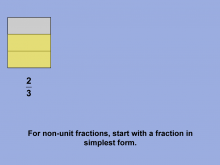
|
Math Clip Art--Fraction Concepts--Equivalent Fractions 11 | Math Clip Art--Fraction Concepts--Equivalent Fractions 11TopicFractions DescriptionThis image starts a new sequence focusing on equivalent fractions of 2/3. It shows a rectangular fraction model divided into three equal parts with two parts shaded, representing 2/3. This representation introduces students to a new fraction and sets the stage for exploring its equivalent forms. It provides a clear visual model for students to understand what 2/3 looks like. Teachers can use this image to begin a discussion about fractions with a numerator greater than 1 and to prepare students for generating equivalent fractions of 2/3. |
Find Equivalent Fractions and Identify and Name Fractions |
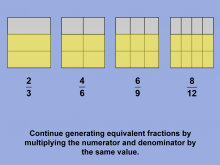
|
Math Clip Art--Fraction Concepts--Equivalent Fractions 15 | Math Clip Art--Fraction Concepts--Equivalent Fractions 15TopicFractions DescriptionThis image serves as a summary slide showing the four equivalent fractions explored in the previous sequence: 2/3, 4/6, 6/9, and 8/12. It displays all four rectangular models side by side, clearly demonstrating their equivalence. |
Find Equivalent Fractions and Identify and Name Fractions |
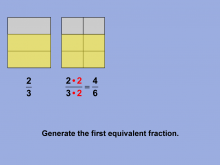
|
Math Clip Art--Fraction Concepts--Equivalent Fractions 12 | Math Clip Art--Fraction Concepts--Equivalent Fractions 12TopicFractions DescriptionThis image shows the next fraction in the sequence: 4/6. It displays a rectangular model divided into six parts with four parts shaded, representing 4/6. It may also include the numerical process of multiplying both the numerator and denominator of 2/3 by 2 to get 4/6. This representation helps students understand how to create equivalent fractions by multiplying both the numerator and denominator by the same number. It provides both a visual and potentially numerical explanation of the process. |
Find Equivalent Fractions and Identify and Name Fractions |

|
Math Clip Art--Fraction Concepts--Equivalent Fractions 09 | Math Clip Art--Fraction Concepts--Equivalent Fractions 09TopicFractions DescriptionThis image completes the short sequence by showing 4/20 with a rectangular model and the numerical process to generate this equivalent fraction. It displays a rectangle divided into 20 parts with four parts shaded, alongside the numerical process of multiplying both the numerator and denominator of 1/5 by 4 to get 4/20. This representation completes the pattern of equivalent fractions for 1/5 and reinforces the concept of generating equivalent fractions by multiplying both the numerator and denominator by the same number. |
Find Equivalent Fractions and Identify and Name Fractions |
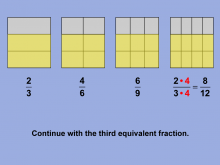
|
Math Clip Art--Fraction Concepts--Equivalent Fractions 14 | Math Clip Art--Fraction Concepts--Equivalent Fractions 14TopicFractions DescriptionThis image shows the final fraction in the sequence: 8/12. It displays a rectangular model divided into twelve parts with eight parts shaded, representing 8/12. It may also include the numerical process of multiplying both the numerator and denominator of 2/3 by 4 to get 8/12. |
Find Equivalent Fractions and Identify and Name Fractions |

|
Math Clip Art--Fraction Concepts--Equivalent Fractions 15 | Math Clip Art--Fraction Concepts--Equivalent Fractions 15TopicFractions DescriptionThis image serves as a summary slide showing the four equivalent fractions explored in the previous sequence: 2/3, 4/6, 6/9, and 8/12. It displays all four rectangular models side by side, clearly demonstrating their equivalence. |
Find Equivalent Fractions and Identify and Name Fractions |

|
Math Clip Art--Fraction Concepts--Equivalent Fractions 15 | Math Clip Art--Fraction Concepts--Equivalent Fractions 15TopicFractions DescriptionThis image serves as a summary slide showing the four equivalent fractions explored in the previous sequence: 2/3, 4/6, 6/9, and 8/12. It displays all four rectangular models side by side, clearly demonstrating their equivalence. |
Find Equivalent Fractions and Identify and Name Fractions |
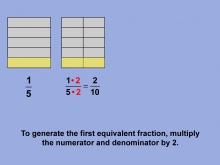
|
Math Clip Art--Fraction Concepts--Equivalent Fractions 07 | Math Clip Art--Fraction Concepts--Equivalent Fractions 07TopicFractions DescriptionThis image builds on the previous one, showing 2/10 with a rectangular model and demonstrating how to generate this equivalent fraction numerically. It displays a rectangle divided into ten parts with two parts shaded, alongside the numerical process of multiplying both the numerator and denominator of 1/5 by 2 to get 2/10. This representation helps students understand how to create equivalent fractions by multiplying both the numerator and denominator by the same number. It provides both a visual and numerical explanation of the process. |
Find Equivalent Fractions and Identify and Name Fractions |
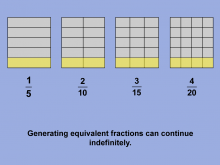
|
Math Clip Art--Fraction Concepts--Equivalent Fractions 10 | Math Clip Art--Fraction Concepts--Equivalent Fractions 10TopicFractions DescriptionThis image serves as a summary slide showing the four equivalent fractions explored in the previous sequence: 1/5, 2/10, 3/15, and 4/20. It displays all four rectangular models side by side, clearly demonstrating their equivalence and reinforcing that this process can continue indefinitely. This representation provides a comprehensive view of the equivalent fractions, allowing students to see the progression and pattern all at once. It reinforces the concept that these fractions, despite looking different, all represent the same amount. |
Find Equivalent Fractions and Identify and Name Fractions |

|
Math Clip Art--Fraction Concepts--Equivalent Fractions 11 | Math Clip Art--Fraction Concepts--Equivalent Fractions 11TopicFractions DescriptionThis image starts a new sequence focusing on equivalent fractions of 2/3. It shows a rectangular fraction model divided into three equal parts with two parts shaded, representing 2/3. This representation introduces students to a new fraction and sets the stage for exploring its equivalent forms. It provides a clear visual model for students to understand what 2/3 looks like. Teachers can use this image to begin a discussion about fractions with a numerator greater than 1 and to prepare students for generating equivalent fractions of 2/3. |
Find Equivalent Fractions and Identify and Name Fractions |

|
Math Clip Art--Fraction Concepts--Equivalent Fractions 14 | Math Clip Art--Fraction Concepts--Equivalent Fractions 14TopicFractions DescriptionThis image shows the final fraction in the sequence: 8/12. It displays a rectangular model divided into twelve parts with eight parts shaded, representing 8/12. It may also include the numerical process of multiplying both the numerator and denominator of 2/3 by 4 to get 8/12. |
Find Equivalent Fractions and Identify and Name Fractions |

|
Math Clip Art--Fraction Concepts--Equivalent Fractions 08 | Math Clip Art--Fraction Concepts--Equivalent Fractions 08TopicFractions DescriptionThis image continues the sequence, now showing 3/15 with a rectangular model and the numerical process to generate this equivalent fraction. It displays a rectangle divided into 15 parts with three parts shaded, alongside the numerical process of multiplying both the numerator and denominator of 1/5 by 3 to get 3/15. This representation further reinforces the concept of generating equivalent fractions and helps students see the pattern emerging in the sequence. |
Find Equivalent Fractions and Identify and Name Fractions |

|
Math Clip Art--Fraction Concepts--Equivalent Fractions 07 | Math Clip Art--Fraction Concepts--Equivalent Fractions 07TopicFractions DescriptionThis image builds on the previous one, showing 2/10 with a rectangular model and demonstrating how to generate this equivalent fraction numerically. It displays a rectangle divided into ten parts with two parts shaded, alongside the numerical process of multiplying both the numerator and denominator of 1/5 by 2 to get 2/10. This representation helps students understand how to create equivalent fractions by multiplying both the numerator and denominator by the same number. It provides both a visual and numerical explanation of the process. |
Find Equivalent Fractions and Identify and Name Fractions |

|
Math Clip Art--Fraction Concepts--Equivalent Fractions 15 | Math Clip Art--Fraction Concepts--Equivalent Fractions 15TopicFractions DescriptionThis image serves as a summary slide showing the four equivalent fractions explored in the previous sequence: 2/3, 4/6, 6/9, and 8/12. It displays all four rectangular models side by side, clearly demonstrating their equivalence. |
Find Equivalent Fractions and Identify and Name Fractions |

|
Math Clip Art--Fraction Concepts--Equivalent Fractions 10 | Math Clip Art--Fraction Concepts--Equivalent Fractions 10TopicFractions DescriptionThis image serves as a summary slide showing the four equivalent fractions explored in the previous sequence: 1/5, 2/10, 3/15, and 4/20. It displays all four rectangular models side by side, clearly demonstrating their equivalence and reinforcing that this process can continue indefinitely. This representation provides a comprehensive view of the equivalent fractions, allowing students to see the progression and pattern all at once. It reinforces the concept that these fractions, despite looking different, all represent the same amount. |
Find Equivalent Fractions and Identify and Name Fractions |

|
Math Clip Art--Fraction Concepts--Equivalent Fractions 14 | Math Clip Art--Fraction Concepts--Equivalent Fractions 14TopicFractions DescriptionThis image shows the final fraction in the sequence: 8/12. It displays a rectangular model divided into twelve parts with eight parts shaded, representing 8/12. It may also include the numerical process of multiplying both the numerator and denominator of 2/3 by 4 to get 8/12. |
Find Equivalent Fractions and Identify and Name Fractions |